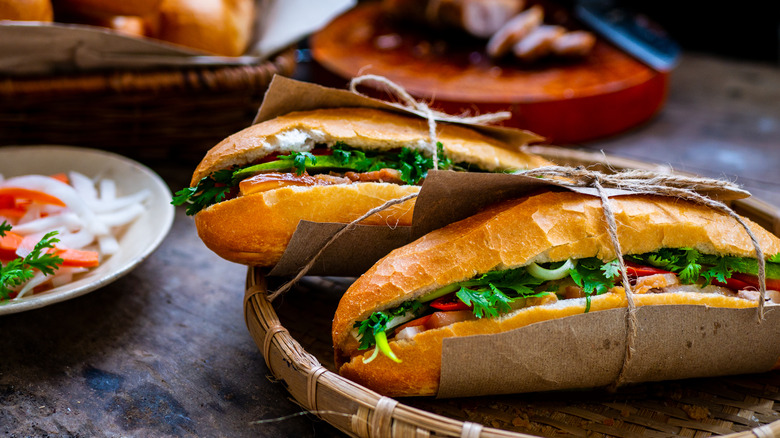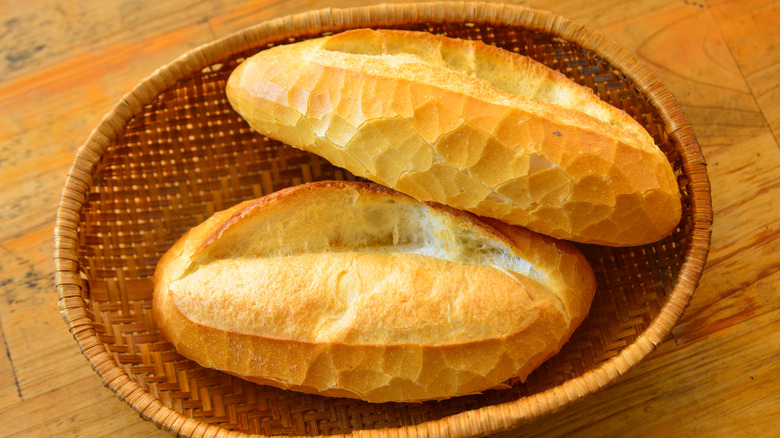Andrew Zimmern's Go-To Sandwich Bread Is Criminally Underrated
Andrew Zimmern, a chef, author, and television host, is arguably most known for starring in "Bizarre Foods" and its spin-off shows on The Travel Channel. While he's famously sampled things like worms, fermented spoiled shark meat, and deep-fried Cambodian tarantulas, he also enjoys simpler fare, like unadulterated sandwiches — particularly those made with Vietnamese baguettes.
In an "Ask Me Anything" segment on his YouTube channel, Zimmern explains how he absolutely loves the bread, and that it's his sandwich bread of choice, pointing out its appealing soft, stretchy texture. Vietnamese baguettes are probably most recognized as the vehicle for a bánh mì sandwich, a delicious creation that emerged during the French colonization of Vietnam in the late 19th century. Vietnamese baguettes differ from classic French ones in that the crust is much thinner, but still has a gorgeous, crispy crunch, and the bread inside is airier and softer. It's everything you want in sandwich bread: The crust is strong enough to hold lots of ingredients intact, but it's not so firm that you can't bite through it easily.
The difference between French and Vietnamese baguettes
Andrew Zimmern has openly expressed his reverence for Vietnam. He told Afar Magazine, "I have been to Vietnam a half dozen times and have experienced so much joy there that on each returning trip I got more and more immersed in living." It can be assumed that it's here where he experienced the authentic Vietnamese baguettes he loves so much.
Naturally, when the French arrived in Vietnam at the end of the 19th century, they brought their foods with them, including their signature baguettes. However, the high humidity in the country didn't fare well for the bread, and it went stale very quickly. Because of this, the bread rolls had to be altered, so they eventually became smaller and lighter with a crust that was thin, crisp, and baked quickly.
Often, but not always, rice flour is added to the dough of Vietnamese baguettes, which helps make the loaves light and airy. While French baguettes are baked in hot, dry ovens, Vietnamese baguettes bake up best in steam ovens, which gives the bread its soft texture and thin crust. Home bakers can use a spray bottle of water to mist the loaves with, in lieu of a steam oven.
Vietnamese baguettes also tend to be a bit sweeter than their French counterparts, and this is part of what makes them perfect for use in bánh mì sandwiches, as it offsets the other savory, tangy ingredients.
A specific bread can make or break a sandwich
Andrew Zimmern's version of a bánh mì sandwich substitutes porchetta for the traditional pork belly, and he omits the pâté. He also doesn't specifically call for using a Vietnamese baguette, perhaps because it's not a roll that is widely available in conventional American bakeries. If you don't order them online or make your own, opt for a softer French baguette. And, as much as he praises the Vietnamese versions, he also doesn't use them when he makes his bánh mì pork burgers, instead opting for standard burger buns.
While Vietnamese baguettes may be Zimmern's top choice — and surely are a wonderful option for everything from turkey and Swiss to a Camembert, ham, and arugula baguette — other sandwiches require specific breads to make them taste their best. A prime example is classic pastrami, which is traditionally served on soft rye bread with a smear of mustard. Some would argue that dill-rye bread is the best, hands-down, for any type of savory sandwich. Grilled cheeses are great on tangy, sturdy sourdough, and white sandwich bread is all you need for a BLT or peanut butter and jelly.



